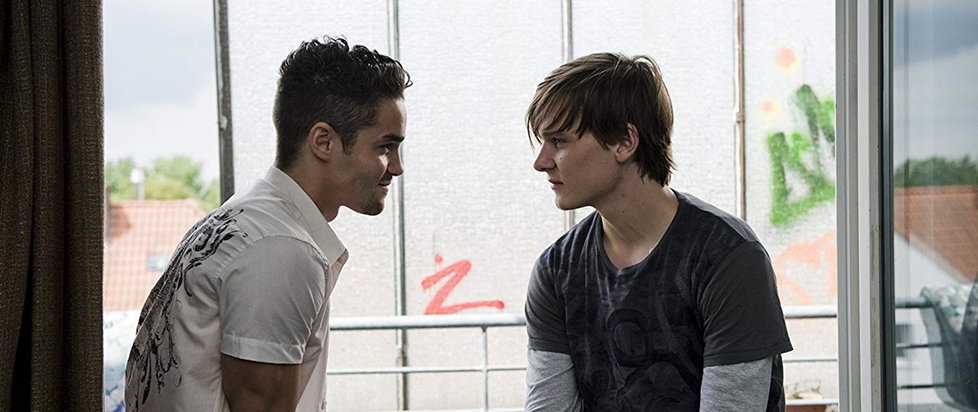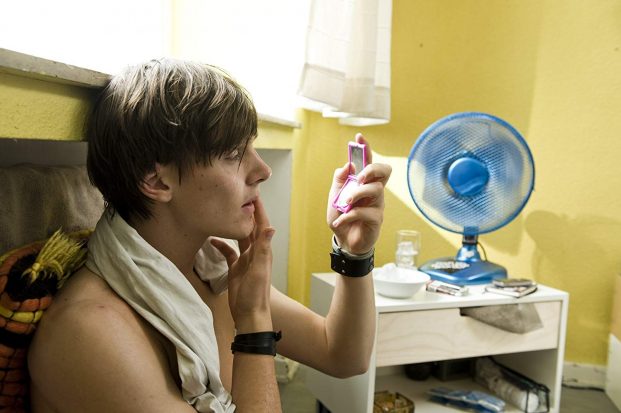
Romeo(s): Where Art Thou?
Narcissus fell in love with his reflection in the water, only to fatally succumb to his own search for the perfect aesthetic. The body is a site for meditation, anxiety, and arousal for trans people—it’s simultaneously the point of conflict and power among us brave enough to name our own desires. But the danger lies in seeing nothing but our reflection, and to lose sight of the world around us and the people we love. Jealousy and selfishness are depicted in the 2011 German film Romeos, as a dark doppelgänger to the trans man protagonist, Lukas. It’s like a modern take on E.T.A. Hoffmann’s short story, The Sandman, with its warning of obsessive behavior and depictions of bachelors plagued by loneliness. But most importantly, Romeos avoids a voyeuristic gaze on the transgender body to focus on the complicated relationships that emerge from trans-cis romances.
Romeos has messy characters for a messy topic—to what extent does a trans person have control over their body and who perceives it? It features Rick Okon as Lukas, a shy trans guy with deep-rooted insecurity, and Max Befort as Fabio, a playboy who happens to still live at home. The two make an unlikely couple, as director and writer Sabine Bernardi wastes no time establishing at their relationship is almost entirely comprised of dramatic ups and downs. Okon and Befort seemingly spend a third of the film chasing after one another in a queer game of tag, forever in a bout of a sporadic lover’s quarrel.
This question of who perceives and judges trans bodies is no doubt one being asked in recent shows like Transparent, which at least attempt to answer it with mixed results. It’s hard writing trans characters. It’s ever harder writing trans characters you’re supposed to empathize with without inadvertently depicting them as overly simplified. People are complex, and queer representation in entertainment deserve a whole spectrum of messy characters. And yet there are still uninitiated audiences and critics to appease—no way can we explain the nuances of trans desire without stepping on cisgender people’s toes. It may even shock them to learn we might find the non-queer public’s fascination with trans bodies particularly uninteresting. Trans character shouldn’t be a mix-and-match of tragedy tropes and empathy fodder. They can also be regular, boring fucking people.

Unlike classics like Boys Don’t Cry and more recent films like Three Generations, Lukas, the trans man hero of Romeos, is played by a cis male actor. In his essay The Reality of the Body: Transgender, Transsexuality, and Truth in Romeos, critic Kyle Frackman claims: “Bernardi’s choice [to choose a cis male actor] represents the end result of the gender-sexual transition; the other directors chose the starting point of it” with regard to this casting decision. I find this frame of thought persuasive because it applies passing (for one gender or another) to the conversation as to whether or not trans people should depict trans characters. Do cis people just make better fictionalized trans people? For example, Kimberly Peirce famously casted Hilary Swank as Brandon Teena, a real-life victim of transphobic hate crimes. Donna Minkowitz, the author of the article about Teena which likely inspired Peirce’s casting decision, has since apologized about framing him as a lesbian in her original piece. As a trans-masculine person, I’ve been chewing on this decision ever since I experienced Peirce’s flick. It’s a hard film to watch, released almost exactly a year from the violent murder of Matthew Shepard in Laramie, Wyoming. But unlike Romeos, which is described as tragicomedy, Boys Don’t Cry casts an ominous shadow of death influenced by real-life events. In the comparatively care-free, sunny version of Cologne, Germany depicted in Romeos, it’s important to contextualize this depiction of trans-masculine subjectivity in relation to its cinematic processors emphasizing the tragedy of their narratives. I’m just not sure a cis actor would be appropriate for such heavy material.
Romeos’ Lukas unapologetically loves men. Importantly—rather than cast a cis woman for the role, Okon is given breast prosthetics and make-up for scenes where Lukas is nude. He’s obsessed with body hair, and close-up shorts of belly hair, armpit hair, and chin hair are lovingly nested throughout the film. Like Narcissus and The Sandman’s Nathanael, Lukas is enamored with his own image—for better or for worse. He constantly has his arms folded across his chest to cover his breasts, which simply exist, rather than being the focus of a voyeuristic gaze. It’s as if in every shot Lukas is checking himself out, either straightening his back or hunching over in a gesture suggesting he’s hiding from—if not himself—the rest of the world. His ex-girlfriend, Ine, is always the first person to point out his methods of self-obsession: his fixation on smelling “manly,” his wardrobe full of jackets, how he awkwardly attempts to socialize around other men. While Ine disappears for half the film, she suddenly returns towards the end to finally give Lukas the call-out he deserves. In his spiraling relationship with the mystery man Fabio, Lukas loses touch with the women in his life during his grinding search for a partner. “You don’t listen or care about me. It’s always trans, trans, trans!” Ine says in the climactic scene on a stairwell, where she trips on Lukas as he chases Fabio to his car. It’s exactly what Lukas needs to hear in his obsessive search for Fabio and approval from other men—he’s fallen into the deep end of the pool of his own reflection, unable to swim out without a metaphorical slap to the face. It’s a nuanced approach to how trans people police their own bodies, and how misguided and toxic this hyperfixation with passing might be.

The depiction of a trans character by a cis actor will always be the second-best option—the ideal situation being actually hiring a transgender actor instead. Maybe it’s time for those in power to start casting trans people for cis roles next—and leave their nose out of our private business. That is to say, while folks like Elle Fanning and Hilary Swank might pique interest in movies for their fame, there might be little to none actual trans representation in the cast. What’s different about the depiction of trans men in Romeos is that it doesn’t see them as women—instead it challenges the audience to them see as men, played by men. There are some exceptional examples where a gender non-conforming actor actually gets casted to play a trans character, however. So far, we’ve seen this happen in much smaller films like Poppy Harrold’s role as a newly-out trans man in Sammy Paul’s and Bertie Gilbert’s Blue Sushi. But this issue is primarily with big-budget narrative films occupied with the trans experience. Yet somehow even with attempts to audition trans actors, “better-qualified” cis actors always get chosen for roles. Are trans bodies too “taboo” for mainstream, non-queer audiences? It seems that it’d just be easier to cast a trans person rather than spend the effort on additional prosthetics and make-up.
It’s time to think more broadly about who can pass as trans when it comes to movies, and whether or not that this has to do with the “authenticity” of someone’s gender. The unfortunate implication of always casting cis men as trans women and cis women for trans men is that it encourages people to see trans people as “acting” their gender, rather than being their gender. In the end, trans people deserve better, complex stories that subvert the precedent we can’t depict our own demographic, our narratives, our messy, all-encompassing bodies. Better now than never.
Blake enjoys lurking the internet at the witching hour and writing essays, games, and short fiction. Follow him on twitter @_dispossessed!





